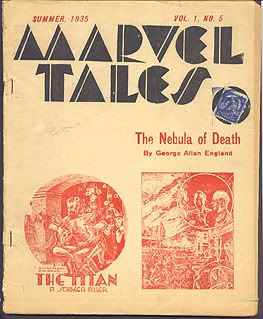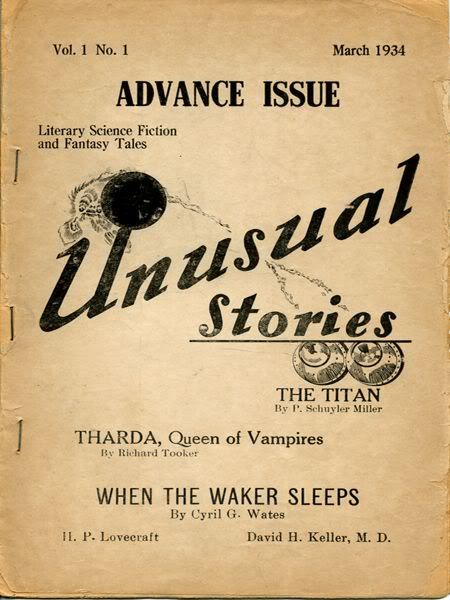Marvel Tales has an interesting, and somewhat confusing history, as it is not quite certain if it was originally intended as a single series that underwent a name-change or was a compliment to an existing series, compounded by the fact that it did not survive past its fifth issue. The science fiction fan community had grown out of the correspondences between readers of professional magazines, such as Amazing Stories and Astounding, who had been contacting one another via those magazines' letters pages. With the deepening of the Great Depression in the 1930s, the fan community began publishing their own works, in part as a response to what was seen by many at the time as a "slowdown," or lack of originality and drive by many of the authors writing for the professional periodicals. Among the earlier of these was a series simply titled Science Fiction (with the subtitle "The Advance Guard of Future Civilization") and was produced in 1933 via mimeograph machine by Jerome Siegel and Joe Shuster, two Cleveland science fiction fans who had been avid readers of Amazing Stories for years; the third issue of this short-lived, five issue series featured "The Reign of the Super-Man," a short novelette (under Siegel and Shuster pseudonym "Herbert S. Fine") chronicling the evil wrought by a nigh-unstoppable Übermensch - a character that would eventually be remolded and reintroduced five years later as Superman, in Actions Comics No. 1.
 |
| The first issue of Siegel and Shuster's Science Fiction. |
Marvel Tales was another such title, the brainchild of William L. Crawford, a science fiction follower and aspiring publisher, who had originally planned to produce a series entitled Unusual Stories. Of his upcoming title, Crawford wrote to other fans in a four-page "preview:"
"Science fiction should have a place in the literature of today. It does not occupy that position now, we believe, because of the restrictions placed on it by short-sighted editors and publishers. They use only tales which follow certain stereotyped forms. They avoid the "off-trail" story because it violates one or another of their editorial taboos, with the result that science fiction has been sinking into the mire of the commonplace."
With his editorial intentions made known, that his magazine would encroach upon "taboos" within the SF field, Crawford released Unusual Stories in, fittingly, a rather unusual manner: the premiere issue (March 1934), the first digest-sized science fiction publication, was sent to readers in two, separate halves. An entire, complete edition was never published.
A second issue failed to appear as well; in its stead, Crawford released Marvel Tales No. 1 (May 1934), which contained many of the stories that the publisher had promised would appear in Unusual Stories. Marvel Tales seemed a combination of both weird-horror and SF, with its inaugural issue containing stories by writers such as Howard Phillips Lovecraft ("Celephais") and Lloyd Arthur Eshbach ("The Man with the Hour Glass"). Actually, Crawford did business with Lovecraft throughout Marvel Tales' existence, printing many of his stories, and even publishing the first, and only, book of Lovecraft's work to be released during the author's lifetime, The Shadow Over Innsmouth (1936). A second issue, dated July/August of 1934 and expanded by twenty pages (along with three variant covers) was released, followed by the sixty-eight page Winter 1934 issue, containing the first published fiction by Robert Bloch ("Lillies"). The March 1935 issue, impressively expanded to 108 pages, contained stories such as "The Doom that Came to Sarnath" (Lovecraft), the first installment of the serial "The Nebula of Death" by George Allan England, and Clifford Simak's religio-science fiction tale "The Creator."
 |
| Marvel Tales Vol. 1 No. 4 - March/April 1935 |
Following the first few issues of Marvel Tales, Crawford sought to expand his reach by announcing a series of books (including the afore-mentioned Shadow Over Innsmouth), in addition to finally publishing a forty-eight page second issue of Unusual Stories (Winter 1935). The previous season (Summer 1935) saw the release of the fifth issue of Marvel Tales, significantly larger than its predecessors in its dimensions, and containing the second installment of "The Nebula of Death," as well as "Man from Makassar" by Carl Jacobi, among other stories. While a sixth issue did indeed make it to the proofing stage (containing yet another printing of "Innsmouth"), No. 5 was the final issue of Marvel Tales, a result of low sales combined with Crawford's "biting off more than he could chew" in regards to expanding his publishing domain.
Williams L. Crawford is acknowledged by many SF historians for reinvigorating the genre during a lull in its early years. True to his claim, Crawford sought to "go against the grain" as it were regarding what was being published in science fiction - he printed Simak's "The Creator," refused by other publishers due its religious nature, and he was the first to accept the serialization of P. Schuyler Miller's "The Titan," which had been rejected by professional editors in light of its descriptions of sexual relations on Mars . Two years after Marvel Tales had folded, Astounding Science Fiction, which had returned after a brief hiatus, began a new era of SF with its hiring of John W. Campbell, Jr. as editor; other changes in the science fiction magazine industry, from Amazing Stories to Wonder Stories, in many cases, are attributed to Crawford. SF historian Michael Ashley, in his The Time Machines - The History of Science Fiction Magazines, credits Crawford with not only injecting much needed inertia into the genre, but also as acting as inspiration for later attempts to challenge science fiction orthodoxy, exampled by Harlan Ellison's 1967 work, Dangerous Visions.
Again, Marvel Tales is one of my favorite titles; short-lived series have always garnered my interest, and I find Simak's "The Creator" (and the issue of Marvel Tales that featured it) to be amongst some of my favorite works. But, it is also the fan aspect that I find most interesting about the title - that a group, which includes Siegel, Shuster, Crawford and a host of others, not only produced work that stands side-by-side with professional publications, but that they also were active in such a "back-and-forth" flow, an inter-connectivity between professionals and fans that helped shape an entire genre of literature. I do no believe that such a relationship, such a community, will carry on into future years - while many who helped shape that world are still participatory and are still "living it," such activity (again, in my mind) is rapidly disappearing, to be replaced by a generation of "fans" whose notion of active participation consists of posting in online forums the extensive nature of their Star Wars action figure collection. At the risk of making posts too long (yet again) I will place any further comments I have regarding this, appropriately enough, in the Comments section. As always, I sincerely thank you for reading, and for your time.
 |
| Marvel Tales Vol. 1 No. 5 - Summer 1935 |
Sources:
Ashley, Mike. The Time Machines - The History of the Science Fiction Magazines from the Beginning to 1950. Liverpool University Press: Liverpool, 2000. 81, 82.
_________ and Robert A.W. Lowndes, ed. The Gernsback Days - A Study of Evolution of Modern Science Fiction from 1911 to 1936. Wildside Press: Holicong, 2004.
Sanders, Joe ed. Science Fiction Fandom. Greenwood Press: Westport, 1994.
Tymn, Marshall B. and Mike Ashley, ed. Science Fiction, Fantasy, and Weird Fiction Magazines. Greenwood Press: Westport, 1985. 401-404.
Images of Science Fiction and Unusual Stories ( as well as Marvel Tales No. 5) are courtesy of The University of Florida Special Studies and Area Collections and the Galactic Central pulp magazine cover archives, respectively.
Issues of Science Fiction, including "Reign of the Super-Man," can be read at The University of Florida's Special Studies and Area Collections webpage, http://ufdc.ufl.edu/UF00077088/00001/1j.
And many thanks to Robert Lichtman for pointing out a few errors on my part regarding early fanzines that have since been rectified.


Speaking of fanzines, the Windy City Pulp convention will see the publication of the latest issues of two excellent pulp fanzines: PULP VAULT and BLOOD n THUNDER. In fact these magazines are edited and published in such a professional manner, that it is possible to argue that they are no longer "fanzines".
ReplyDeleteMadison, thanks for posting this article on MARVEL TALES. I hope you can attend one or both of the pulp conventions.
Thank you for posting, Walker! - I agree about the quality of Blood n Thunder, and can say it is certainly a fanzine in the sense that it is produced by individuals who care deeply about pulps and related works; the production quality is top-notch. And, indeed, I am hoping to make it to Pulpfest this summer, but that will depend on a few factors; Windy City is a bit out of my reach at the moment, I am afraid.
ReplyDeleteThis made for very interesting reading and I learned a great deal.
ReplyDeleteI discovered your blog in the course of trying to determine what price a copy of Marvel Tales V.1, No.5 Summer 1935 might go for, as I have one to sell, and as it turns out I own the very copy seen on this page!
Forry Ackerman, who contributed his autobiography in both English and Esperanto to this issue when he was 19, signed this copy for me, "Marvel-ous! Forrest J Ackerman, Oct. 2000" on the Table of Contents page.
Might you or any readers here suggest a fair market value or direct me to a price guide?
The copy is complete. Nothing is missing, torn or cut and there is no writing other than Forry's. The spine is delicate, with a number of splits and tiny pieces gone, but it still holds the cover together.
Any advice much appreciated!
Thank you so much.